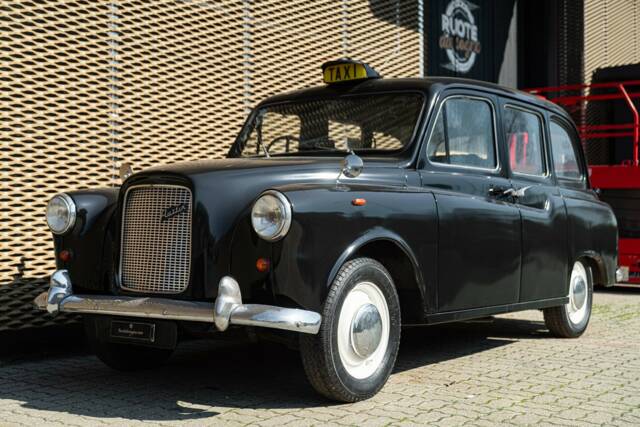Austin FX4 Classic Cars for Sale
The Austin FX4, known worldwide as the classic London taxi, blends unmistakable looks with proven robustness. Produced from 1958 to 1997, the FX4 series saw a range of petrol and diesel engines, plenty of specialist adaptations—including limousine and hearse variants—and is supported by a steady supply of spare parts from the UK.
Search results

1961 | Austin FX 4 D London Taxi
2025-03-05 17:07:07 | Austin FX4 "LONDON TAXI"

1970 | Austin FX 4 London Taxi
Austin-FX4 Taxi RHD
The story behind the Austin FX4
The Austin FX4 represents a significant evolution in British automotive history and is synonymous with the image of the London black cab. Introduced in 1958 as the successor to the FX3, the FX4 was developed in cooperation with Mann & Overton (predominant London taxi dealership) and Carbodies (coachbuilder). Its development focused on purpose-built durability for taxi use, incorporating a robust separate chassis and a partition between driver and passenger for added rigidity and practicality. Originally fitted with a 2178cc diesel and automatic transmission, engine and equipment variations appeared over the FX4's long run. Key milestones include the introduction of a petrol version in 1962, the switch to a 2520cc diesel in 1971, and a range of mechanical and design updates through the decades. When Carbodies took over in 1982, production continued under the FX4R designation with Land Rover-derived diesel engines, and later with the much-improved FX4S and the highly regarded Fairway variant. After nearly 40 years, production ended in 1997 with the introduction of the TX1.
Development of the Model Series
The FX4 model succeeded the FX3, introducing a four-door structure and improved passenger comfort. Facelifts and mechanical changes reflected shifts in ownership and technology: from the FX4D's engine upgrade in 1971, to the FX4R's Land Rover engines in the 1980s, and the FX4S and FX4 Fairway adaptations in the late 1980s and early 1990s, which included improved reliability, comfort, and accessibility. The direct successor after 1997 was the TX1, developed by London Taxis International, which built upon the FX4's specification but introduced modern technologies and emissions compliance.
FX4 Special Features and Market Data
One of the FX4's most striking features is its purpose-built design for the rigours of urban taxi service, evidenced by the partitioned interior, durable chassis, and ease of maintenance. Notably, the flexibility of the FX4 platform led to unusual variants, including six-door limousines and funeral vehicles. Iconic 'bunny ears' turn signals atop the roof further distinguish earlier models. The FX4 is renowned for its availability of spare parts and ease of restoration, with many components sourced directly from the UK, securing its longevity among enthusiasts and professionals alike.
Technical Specifications of the Austin FX4
Special Editions and Noteworthy Variants
The FX4 platform gave rise to rare six-door stretched limousine adaptations (FL2, 1958–1976, 1982), some with cocktail bars and advanced audio—vehicles owned by figures like Prince Philip and Laurence Olivier. The 1989 Fairway and Fairway Driver models, featuring Nissan diesel power and improved handling, are especially sought after by enthusiasts due to enhanced driveability and reliability. Hearse conversions are also known, reflecting the FX4's lasting adaptability.
Maintenance and Common Issues
The FX4 was engineered for the demands of intensive taxi service, resulting in mechanical reliability. Regular maintenance, particularly of the diesel engines and automatic gearboxes, is essential due to heavy prior professional use. Bodywork includes large metal panels, making rust a frequent concern and restoration a significant project. However, strong parts support from the UK, including body parts, ensures ongoing usability. Interior wear varies; in many cases, taxi-standard upholstery and fittings remain robust, and well-preserved examples occasionally surface.
Engine, Driving, and Handling
Early FX4s with diesel engines were optimized for reliability over speed, prioritising low-end torque for city driving. Manual gearboxes offered in the 1960s allowed greater driver control, while later automatics provided ease for long taxi shifts. The 1989 Fairway's Nissan diesel engine dramatically improved performance, reliability, and refinement, making these variants more suitable for enthusiasts seeking regular use. Steering and ride comfort were enhanced in later models with the addition of power steering, disc brakes, and improved suspension, turning-market variants like the Fairway Driver into the most pleasant to operate. 1. Austin FX4 Fairway (1989–1997): Reliable Nissan TD27 diesel engine, improved comfort, excellent availability of spare parts. 2. Austin FX4S-Plus (1987): Extra seating for a fifth passenger, added driver comfort features. 3. Austin FX4R (early 1980s): Land Rover diesel engine, power steering, upgraded braking system.
Interior and Exterior Design
The FX4's coachbuilt origins are apparent in its spacious and squared passenger compartment, strict driver/passenger partition, and purpose-driven details such as the 'bunny ears' roof indicators. Materials are robust throughout, stressing utility—upholstery is durable vinyl or fabric, and controls are designed for heavy wear. Exterior paint is most often finished in black, but fleets and private owners sometimes specified other colours for specialist use (limousines, hearses). Accessories include fare meters, roof lights, wheelchair ramps in later FX4W variants, and specialist interior fittings in limousine adaptations. Alloy wheels and improved trim featured on Fairway editions, setting them apart aesthetically and functionally.
Other Distinctive Features
Thanks to its notoriety as a London taxi, the FX4 frequently entered pop culture, being used in film and on TV. Some vehicles originate from overseas fleets (e.g., Saudi Arabia), testifying to the model's international reach. Restoration is aided by a dedicated enthusiast scene and strong aftermarket support in the UK, facilitating preservation and even daily use.
Summary
The Austin FX4 stands as the definitive British taxi, developed for near-continuous professional use across four decades. With versions tailored for comfort, accessibility, and unique applications like limousines and hearses, the FX4 remains instantly recognisable and practical for restoration. Ongoing parts availability, robust mechanicals, and enduring cultural relevance keep the FX4 a mainstay in the classic car marketplace.

